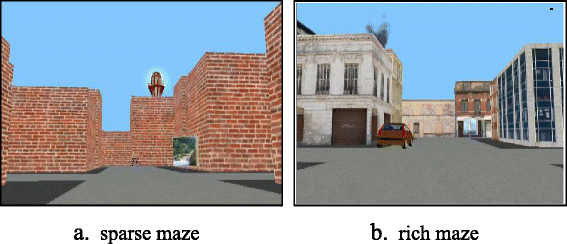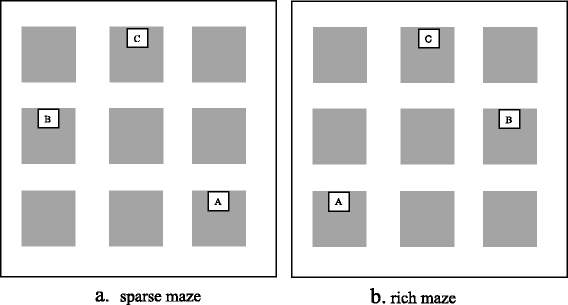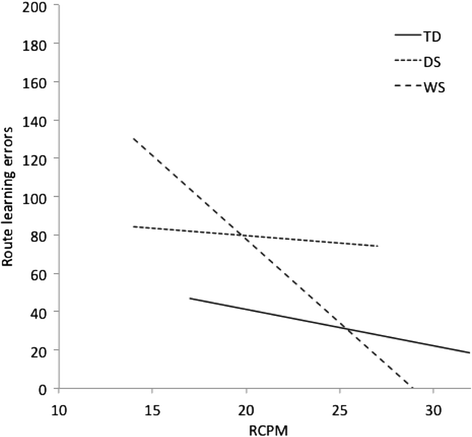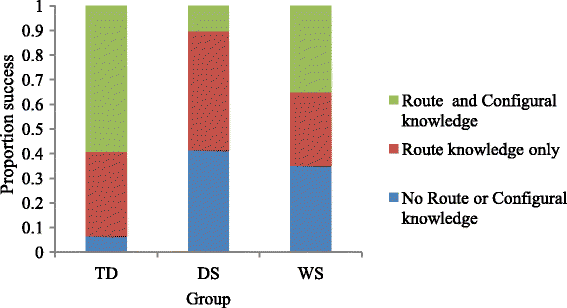Route knowledge and configural knowledge in typical and atypical development: a comparison of sparse and rich environments
- PMID: 26870305
- PMCID: PMC4750629
- DOI: 10.1186/s11689-015-9133-6
Route knowledge and configural knowledge in typical and atypical development: a comparison of sparse and rich environments
Abstract
Background: Individuals with Down syndrome (DS) and individuals with Williams syndrome (WS) have poor navigation skills, which impact their potential to become independent. Two aspects of navigation were investigated in these groups, using virtual environments (VE): route knowledge (the ability to learn the way from A to B by following a fixed sequence of turns) and configural knowledge (knowledge of the spatial relationships between places within an environment).
Methods: Typically developing (TD) children aged 5 to 11 years (N = 93), individuals with DS (N = 29) and individuals with WS (N = 20) were presented with a sparse and a rich VE grid maze. Within each maze, participants were asked to learn a route from A to B and a route from A to C before being asked to find a novel shortcut from B to C.
Results: Performance was broadly similar across sparse and rich mazes. The majority of participants were able to learn novel routes, with poorest performance in the DS group, but the ability to find a shortcut, our measure of configural knowledge, was limited for all three groups. That is, 59 % TD participants successfully found a shortcut, compared to 10 % participants with DS and 35 % participants with WS. Differences in the underlying mechanisms associated with route knowledge and configural knowledge and in the developmental trajectories of performance across groups were observed. Only the TD participants walked a shorter distance in the last shortcut trial compared to the first, indicative of increased configural knowledge across trials. The DS group often used an alternative strategy to get from B to C, summing the two taught routes together.
Conclusions: Our findings demonstrate impaired configural knowledge in DS and in WS, with the strongest deficit in DS. This suggests that these groups rely on a rigid route knowledge based method for navigating and as a result are likely to get lost easily. Route knowledge was also impaired in both DS and WS groups and was related to different underlying processes across all three groups. These are discussed with reference to limitations in attention and/or visuo-spatial processing in the atypical groups.
Keywords: Development; Down syndrome; Navigation; Spatial cognition; Williams syndrome.
Figures




Similar articles
-
Route-learning strategies in typical and atypical development; eye tracking reveals atypical landmark selection in Williams syndrome.J Intellect Disabil Res. 2016 Oct;60(10):933-44. doi: 10.1111/jir.12331. J Intellect Disabil Res. 2016. PMID: 27634746
-
Sequential egocentric navigation and reliance on landmarks in Williams syndrome and typical development.Front Psychol. 2015 Feb 25;6:216. doi: 10.3389/fpsyg.2015.00216. eCollection 2015. Front Psychol. 2015. PMID: 25762973 Free PMC article.
-
Egocentric and allocentric navigation strategies in Williams syndrome and typical development.Dev Sci. 2014 Nov;17(6):920-34. doi: 10.1111/desc.12176. Epub 2014 Apr 7. Dev Sci. 2014. PMID: 24702907
-
A Critical Review of Spatial Abilities in Down and Williams Syndromes: Not All Space Is Created Equal.Front Psychiatry. 2021 May 28;12:669320. doi: 10.3389/fpsyt.2021.669320. eCollection 2021. Front Psychiatry. 2021. PMID: 34122185 Free PMC article. Review.
-
From genes to brain development to phenotypic behavior: "dorsal-stream vulnerability" in relation to spatial cognition, attention, and planning of actions in Williams syndrome (WS) and other developmental disorders.Prog Brain Res. 2011;189:261-83. doi: 10.1016/B978-0-444-53884-0.00029-4. Prog Brain Res. 2011. PMID: 21489394 Review.
Cited by
-
The Acquisition of Survey Knowledge by Individuals With Down Syndrome.Front Hum Neurosci. 2020 Jul 3;14:256. doi: 10.3389/fnhum.2020.00256. eCollection 2020. Front Hum Neurosci. 2020. PMID: 32719594 Free PMC article.
-
Dissociable spatial memory systems revealed by typical and atypical human development.Dev Sci. 2019 Mar;22(2):e12737. doi: 10.1111/desc.12737. Epub 2018 Sep 18. Dev Sci. 2019. PMID: 30176106 Free PMC article.
-
Studying the Development of Navigation Using Virtual Environments.J Cogn Dev. 2023;24(1):1-16. doi: 10.1080/15248372.2022.2133123. Epub 2022 Oct 19. J Cogn Dev. 2023. PMID: 37614812 Free PMC article.
-
Neonatal Care Unit Interventions on Preterm Development.Children (Basel). 2023 Jun 2;10(6):999. doi: 10.3390/children10060999. Children (Basel). 2023. PMID: 37371231 Free PMC article. Review.
-
A Virtual Object-Location Task for Children: Gender and Videogame Experience Influence Navigation; Age Impacts Memory and Completion Time.Front Psychol. 2018 Apr 4;9:451. doi: 10.3389/fpsyg.2018.00451. eCollection 2018. Front Psychol. 2018. PMID: 29674988 Free PMC article.
References
-
- Bellugi U, Sabo H, Vaid J. Spatial deficits in children with Williams syndrome. In Stiles-Davis J , Kritchevshy U, Bellugi U, editors. Spatial cognition: Brain bases and development. Hillsdale, New Jersey: Lawrence Erlbaum. 1988; p. 273–97.
-
- Breckenridge K, Atkinson J, Braddick O. Attention. In: Farran EK, Karmiloff-Smith A, editors. Neurodevelopmental disorders across the lifespan: a neuroconstructivist approach. Oxford: University Press; 2012. pp. 119–34.
-
- Broadbent HJ, Farran EK, Tolmie A. Egocentric and allocentric navigation strategies in typical development and Williams syndrome. Developmental Science. 2014a;17:920–34. - PubMed
-
- Broadbent HJ, Farran EK, Tolmie A. Object-based mental rotation and visual perspective-taking in typical development and Williams syndrome. Developmental Neuropsychology 2014b;39:205–25. - PubMed
LinkOut - more resources
Full Text Sources
Other Literature Sources

